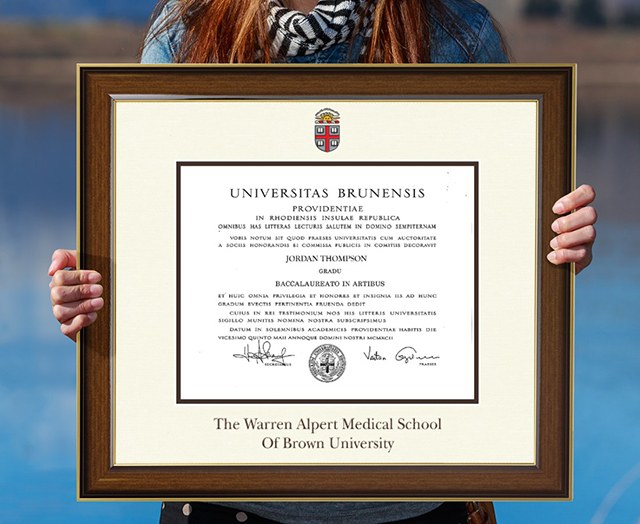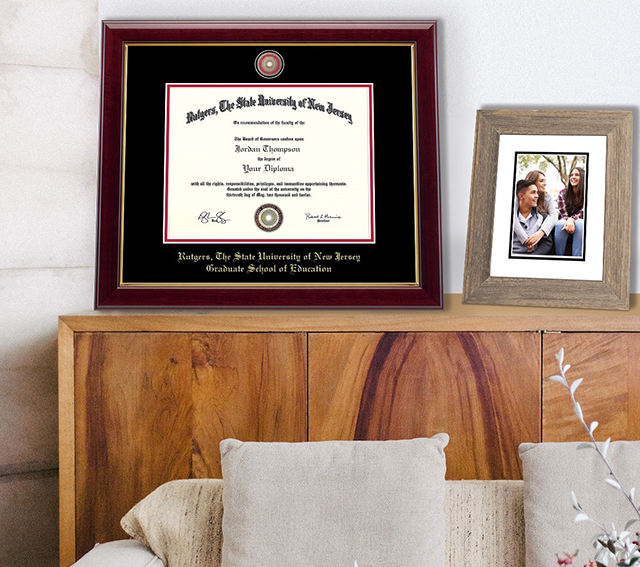
Choosing a graduate school can be a difficult process because you never want to wind up regretting your decision later. Depending on your field of study, in many cases, the graduate school you select will be your education provider for the next two or three years.
However, simply knowing the gravity of the decision doesn’t necessarily equip you with any information that will help you make a more informed selection. To ensure you’re fully satisfied with the master’s or doctoral degree program you choose, it’s best to conduct your comparison using a multifaceted approach that considers every possible factor in the process. That way you can eliminate the possibility of overlooking an essential attribute or feature that should have been taken into consideration initially.
Best of all, when you finally receive your master’s or doctoral degree, you can showcase it in a Church Hill Classics diploma frame featuring the official embossed name of your university along with a second line of embossing for the grad school you attended. To find your grad school, simply search for your college or university and then (if available) click on the drop-down “Graduate & School-Specific Programs” menu to select your specific grad school.
In this comprehensive guide, we’ll go over the 20 steps you should take when comparing your top graduate schools.
1. Consider How the Actual Diploma Will Look in the Frame
This might seem like a trivial aesthetic factor with which to start, but eventually, it will be the key attribute that will still matter after you’ve graduated. Two decades from now, when you have all of your accolades and awards framed and hung up in your office or den, you’re not going to care about any of the other factors on this list. At that point, all you’ll see in front of you is the master’s degree itself inside the frame. Likewise, you may want to accompany the diploma with a few photo frames or ‘Class of’ frames that will capture pictures of you and your classmates and college friends. What’s more, with frames available with an extra line of embossing for specific grad schools, you can truly showcase your hard work for years to come and highlight the school where you worked hard to earn that degree.
2. Decide Between Offline, Online, or a Mix of the Two
Deciding between offline and online courses will play a large part in your graduate school journey. Depending on your ability to study and the kind of structure and format that best suits you, you can find a degree tailored to those needs. Offline study (seminars, workshops, etc.) may be your preferred method of learning. Most schools offer this kind of learning as well as modules that can be completed online in their entirety. The great thing about online courses is that they offer flexibility for students juggling school, work, and family obligations. It’s best to look into what each grad school offers in the way of online and offline courses, as this can help determine your preferred school.
3. Check Out the Campus or Try Out the Online Interface
If you decide to study offline at a physical school, the next step would be to take a tour to see how you like the look and feel of the campus and the classrooms. Are the staff and students friendly and welcoming? How does it compare to the other schools you’ve toured? Make a list of at least seven questions you’ll want answered about the campus during your tour. If you chose the online route, be sure to browse the school’s website extensively, as design and user-friendliness will be the main factors to consider for a web-based degree program.
4. Give Yourself Time to Research
Many students make the mistake of waiting until the application deadline is just weeks away before applying to a whole list of universities. That’s a terrible idea because all of your applications will be rushed and, more importantly, you won’t have enough time to do the necessary research. In general, try to give yourself at least three months to conduct the comparison. That might seem like a long time, but it’s a drop in the bucket compared to the amount of time and money you’ll invest in the school.
5. Be Confident in Your Degree Selection
The most common approach when creating an initial list of prospective schools is to search for universities based on the type of degree you’re trying to earn. Thus, if you haven’t already conducted a comparison of a similar magnitude to this one in regard to which degree you’re pursuing, it would be best to start there. You can get some great advice on how to choose a major from this guide.
6. Start with a List of Least 15 Schools
A common question that prospective grad students have is how many schools they should be considering in their comparison. Generally, the answer to that is: “the more, the better.” However, for the sake of keeping the process manageable, it’s best to start with a base of 15-20 schools and then narrow down your options from there. If you’re still not satisfied, you can sift through another batch of 20 schools and repeat the process. Comparing too many schools at once can be confusing while comparing too few will limit your options.
7. Consider Your Alma Mater
Ideally, it’s best to choose a school that you can use to earn your initial degree and any other advanced degrees that will help in your career later on. This will simplify the process of re-enrolling, resuming classes, and transitioning from one phase of your education to another because the school where you earned your bachelor’s degree will already have your information on file to get you started on your master’s degree.
8. Look for News Stories or Press Releases About the College
This might not be a crucial step, but it’s an interesting extra measure to take because it helps you learn about the school’s reputation, recent events, and other newsworthy facts that you might not have known otherwise. Maybe the campus just added a massive auditorium last year. Or, maybe the school recently raised their tuition prices or is having issues with campus safety. Headline-worthy facts like that are certainly worth investigating.
9. Use a Spreadsheet to Track Your Prospects and Applications
One of the easiest ways to keep track of everything when applying for multiple schools is to use a spreadsheet. On the left side of the sheet, you can create a column that contains the names of the schools you’re comparing. Then at the top, you can create columns for each of the factors that you’re taking into account, such as the school’s location, tuition fees, housing options, program benefits, and financial aid.
10. Call the Admissions Office
Speaking with the school’s admissions office is always a good idea because it gives you an idea of how responsive, friendly, and helpful they are. Using your spreadsheet, you can add a few columns for “Responsiveness,” “Friendliness,” and “Helpfulness.” In the Responsiveness column, you can list the amount of time it took for them to respond to your email or phone call. Under the Friendliness and Helpfulness columns, you could put a rating like “very” or “not very.”
11. Speak to Students and Staff
Just as it’s important to speak to the people who are in charge of admissions, it’s also a good idea to have a conversation with students who are currently enrolled in the graduate school program. If you can’t find anyone available on campus, you can probably find one of the school’s students through social media groups. Additionally, speaking to a professor or teacher that works there might give you an indication of the quality of the school’s educators.
12. Do Your Best on Each Application
Another reason why it’s best to keep your initial list to no more than 20 schools is that you also need to give yourself enough time to be thorough on each application. Every school will have a different application process, so you need to be sure you’re following their specific instructions. Furthermore, some schools might even ask you to write an essay to secure approval. Since it’s possible for an applicant to be rejected based on a low-quality submission, you need to be prepared to put together an impressive application for each school. After all, being turned down by your dream university would completely negate any advice related to comparing graduate schools.
13. Ask about Apprenticeship Opportunities
Many schools have connections with unions and companies that help you land your first apprenticeship immediately after graduation. While not all industries and job positions have apprenticeships, this is definitely something to look into as a means of expediting the process of getting your first paying job in the field
14. Look into Internship Possibilities
It’s also common for schools to provide internship opportunities to their students through similar networking connections that facilitate apprenticeships. Some degree types or certifications will require a certain amount of experience before you can be considered a licensed professional.
15. Work on Your Resume While You Search
It’s a common misconception that you need to have extensive work experience to have a good-looking resume. A student resume doesn’t have to show just work experience; it can just be a summary of your academic strengths and participation in clubs and campus events. Check out this guide to fixing up your resume as a college student to see how you can start taking steps toward becoming a more eligible job candidate before you even choose your grad school.
16. Take Advice from Friends and Family
Asking other people which grad school you should attend may not seem wise, but you might just be surprised by some of their recommendations. At least by asking for the input of others, you can be sure you’re not overlooking any options that might be a perfect fit in the long run.
17. Consider Studying Aboard
If you’ve been limiting your options to schools that are located in your home country, you could be missing out on some of the best travel and cultural memories of your life. For the sake of giving everything equal consideration, you may want to include five to ten foreign schools on an extra tab on your spreadsheet called “Abroad.” Likewise, many American universities offer study abroad opportunities for graduate students.
18. Use Social Media to Collect Feedback
Just as asking friends and family could yield surprising results, you could find some useful guidance on social media. If you were to go out in public and search for other college students, finding them by chance would be difficult. Sites like Facebook make it easy to find many students that go to the same school in a matter of minutes, so you can also start building your social network at different schools before you choose one.
19. Examine Other Degree Types
As mentioned earlier, basing your school selection solely on the degree type that you’re pursuing can be a huge mistake. If that’s the approach you’re taking, you need to at least make sure you’ve considered all possible routes as the degree you choose will affect what jobs will be available to you for years to come. It’s a good exercise to consider at least three to five alternatives aside from the main concentration that you already have in mind.
20. Should You Follow Your Friends?
Many students are inclined to follow their best friends to the grad school they’ll be attending. This isn’t always a bad idea, but you need to honestly ask yourself if your relationship with your friend is going to be beneficial at the new school, and you need to determine if the school itself is worthy of attending based on all of the factors listed above. There’s no sense in choosing the school at which you’ll be studying for the next few years based entirely on a decision that someone else has made, regardless of how good of a friend they are.
Should the Comparison Really Involve 20 Steps?
Any time you’re trying to be thorough about anything, a minimum set of about 10-20 repetitions is a good rule of thumb. Just as we recommended a starting list of at least 15-20 schools as a base for your comparison, it also makes sense to base your comparison on a minimum of ten factors. Thus, by using a list of 20 factors, you’re essentially being twice as thorough as you need to be. With that strategy, you can feel confident that you’ve chosen the right graduate school on your first day of enrollment.





















